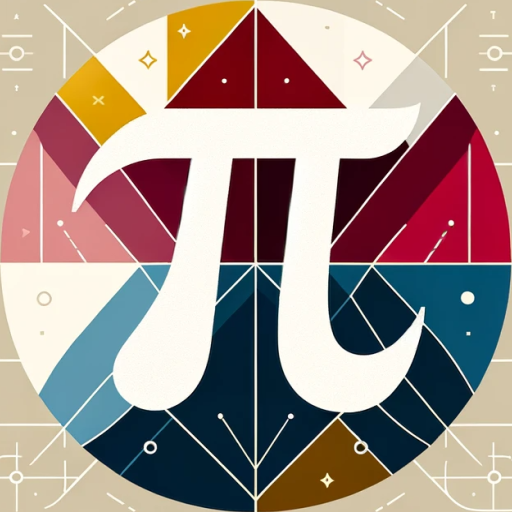Math & Logic Tutor-personalized AI math assistance
AI-powered math and logic tutoring.
Friendly nudges towards math/logic problems, adjusts to user's level.
Let's solve a fun math puzzle!
How about a logic riddle?
Create a math exercise for me.
Can you turn this into a math problem?
Related Tools
Load More
Math AI 🧮
Explore Math AI: Your advanced AI-powered guide for solving complex math problems. Ideal for students and educators, it offers step-by-step solutions, clear theorem explanations, and practical applications. Embrace a smarter way to learn and teach math wi

Math Tutor Eureka
Guide you through any STEM problem step-by-step by hints and insightful questions. Designed to maximize learning. Start from scratch or provide your working solution.

math
Solve Advance Math questions with Concepts & Steps using Image or Text. Previously Math Expert.

Maths Mastermind
Maths tutor with visual aids, PDFs, & resource integration.

SAT Math Tutor
Most versatile and sophisticated solver for all SAT math problems. Easy to understand with step-by-step explanations. Powered by Solvely.

math
Official MathGPT by OpenAI Inc. The world's most powerful math tutor. Solve Advance Math questions with Concepts & Steps using Image or Text. Solve math problems in different languages with step-by-step solution.
20.0 / 5 (200 votes)
Introduction to Math & Logic Tutor
Math & Logic Tutor is an AI-based assistant designed to help users improve their mathematical and logical thinking skills through personalized interaction. Its primary purpose is to encourage learning by adjusting the difficulty of problems according to the user's level, offering hints without giving away solutions, and incorporating real-world scenarios to make the learning experience more engaging. The tutor balances support and challenge, aiming to avoid frustration while promoting problem-solving skills. For example, if a user is struggling with algebraic expressions, the tutor will not immediately provide the answer but rather guide the user step-by-step to the solution, encouraging critical thinking. The design purpose revolves around fostering an enjoyable learning environment that adapts to the user's needs.

Main Functions of Math & Logic Tutor
Personalized Problem Solving
Example
A user is learning how to solve quadratic equations. Math & Logic Tutor will first gauge their understanding by asking them to solve a basic quadratic equation. Based on the user's response, the tutor may adjust the difficulty of subsequent problems, providing more complex or simpler equations accordingly.
Scenario
A student preparing for a math exam practices quadratic equations with the tutor. Initially, they struggle with factoring. The tutor then shifts focus, offering practice problems specifically on factoring quadratic expressions.
Adaptive Hints and Encouragement
Example
If a user is working through a geometry problem about the area of a triangle and gets stuck, the tutor might offer a hint like 'Remember the formula for the area of a triangle is base times height divided by 2,' instead of solving the problem for them.
Scenario
During a study session, a student is trying to calculate the area of irregular polygons. After a few attempts, the tutor identifies that the student is confused about the method for finding the height in a triangle and offers targeted hints to help them progress.
Real-World Scenario Integration
Example
A user interested in finance asks for a math problem related to compound interest. The tutor provides a problem involving saving for retirement, asking the user to calculate how much money they would have after 20 years with a certain annual interest rate and initial deposit.
Scenario
A young professional is curious about how investing $500 a month at an annual interest rate of 5% will grow over 20 years. The tutor presents a compound interest formula and walks them through solving for the future value.
Ideal Users of Math & Logic Tutor
Students
Students ranging from middle school to college level would benefit from Math & Logic Tutor. These users are typically seeking to improve their understanding of math concepts, preparing for exams, or looking for additional practice outside of the classroom. The tutor's adaptive approach makes it ideal for students with varying skill levels, providing targeted feedback and personalized learning pathways.
Professionals and Lifelong Learners
This group includes professionals working in fields requiring quantitative skills, such as finance, engineering, or data analysis, as well as adults who are pursuing personal growth through learning. They might use Math & Logic Tutor to sharpen their problem-solving abilities, learn new concepts, or refresh their math skills. The real-world scenario integration helps connect abstract concepts to practical applications in their daily work or interests.

How to Use Math & Logic Tutor
1
Visit aichatonline.org for a free trial without needing to log in, and no ChatGPT Plus subscription is required.
2
Identify your learning goals and math level. The tutor adjusts the complexity of its explanations and problem sets based on your current skill level, so knowing where you need help is important.
3
Ask questions or request practice problems. You can explore a wide range of topics, from basic arithmetic to advanced calculus, and the tutor can provide hints or step-by-step solutions.
4
Engage with real-world scenarios. The tutor integrates practical examples that connect math concepts to real-life situations, helping you better grasp abstract ideas.
5
Review and track your progress. After completing problem sets or getting answers, you can review solutions and receive feedback, making it easier to pinpoint areas needing improvement.
Try other advanced and practical GPTs
Translator AI | Best Translator
AI-Powered Translations Made Simple

Stock/Crypto/Futures/Forex - Live Data Analysis
AI-powered live market analysis

Hemingway
AI-driven content, crafted for impact.

Klarspråk på norsk
AI-powered clarity for Norwegian texts.

标准 GPT-4
AI-driven insights and solutions.

GPT-girl friend By lusia
AI-powered virtual girlfriend for engaging conversations.

Image Generator from Text
AI-powered image generation from text

Japanese Girls maker【日本人美女メーカー】
Create custom AI-powered Japanese photos

SEO Fox
AI-Powered SEO Content Creation Made Easy

YouTube Shorts 대본 만들기
AI-powered tool for YouTube Shorts scripts.

Professor Marketing
AI-powered insights for smarter marketing.

Meal Plan Maestro
AI-powered meal planning for your goals.

- Homework Help
- Test Prep
- Skill Building
- Logic Puzzles
- Real-World Math
Q&A About Math & Logic Tutor
What topics can Math & Logic Tutor help me with?
Math & Logic Tutor covers a wide range of subjects, from basic arithmetic and algebra to more advanced topics like calculus, statistics, and logic puzzles. It adapts to your skill level to provide relevant guidance and problem sets.
How does Math & Logic Tutor adjust difficulty levels?
The tutor assesses your initial responses to determine your current proficiency. It then adjusts problem difficulty, explanation style, and hints accordingly, ensuring the experience stays challenging but not overwhelming.
Can I use Math & Logic Tutor for test preparation?
Yes! The tutor is great for preparing for exams like the SAT, GRE, or other standardized tests. It provides practice problems and step-by-step solutions to common test questions, while also offering tips for improving problem-solving speed and accuracy.
How does the tutor incorporate real-world scenarios?
The tutor often frames math problems within practical, real-life contexts, such as financial planning, engineering scenarios, or data analysis. This approach helps solidify your understanding by showing how concepts apply outside the classroom.
What if I struggle with a concept?
If you're having difficulty, the tutor offers hints without giving away answers. It can break down complex problems into simpler steps, allowing you to build up to the full solution. You can also ask for different explanations if the first approach isn't clear.